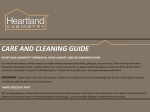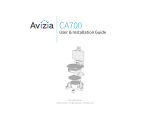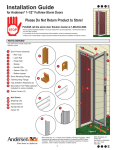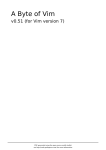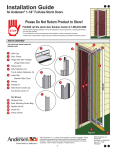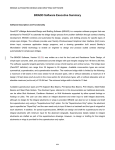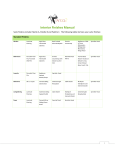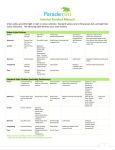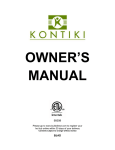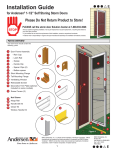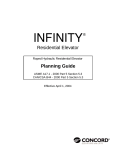Download KraftMaid VLC152188R.S.7118PN Installation Guide
Transcript
CABINETRY installation, care and cleaning Warranty/Records The Beauty of Wood 3 4–5 Wall Lateral Bi-Fold Adjustments 16 Lazy Susan Adjustments 17 Easy-Reach Super Susan Installation guide Preparation 7 Soffits 7 Wall Cabinets 8 Fillers 8 Base Cabinets 9 Fine-Tuning 10 Troubleshooting 10 Adjustments 18 Tri-View Mirror Adjustments 18 Low-Voltage Lighting Adjustments 18 Care & Cleaning Wood Care Recommendations 19 Chemical Resistance 20 Melamine & Thermofoil Making Adjustments Hinge Adjustments: 11-13 Drawer Front Adjustments 13 Drawer Runner Adjustments 14 Drawer Box Adjustments 14 Door & Drawer Bumper Adjustments Surfaces 20 Decorative Hardware 21 Cutlery Divider 21 Knife Section Unit 21 Glass Door Inserts 21 Mirrors 21 Utensil Tray 21 14 Base Wastebasket Adjustments 15 Tambour Unit Adjustments 16 Cutting Centers & Chopping Blocks 22 Touch-Up of Damaged Surfaces CALIFORNIA CONSUMER PROPOSITION 65 WARNING Warning: This product contains chemicals known to the state of California to cause cancer table of contents *The content in this catalog is applicable to cabinets built after January, 2012. 22-23 Thank you & congratulations Thank you for selecting our cabinetry for your home. Your decision reflects your distinguished taste and appreciation for smart design and uncompromising quality. We are proud of our outstanding workmanship. We use only the finest materials, crafted with a meticulous attention to detail — resulting in exceptional cabinetry for the entire home. We are proud of this handcrafted workmanship, and trust that you and your family will be too. product information label Again, thank you for choosing our cabinetry and allowing us to beautify your home. Please read this guide carefully To ensure the long life and beauty of your new cabinetry, please Warranty Your retailer will provide you with a copy of the warranty for your cabinetry. To exercise your warranty, please contact the retailer whom you purchased the product from. take the time to read this booklet carefully. It contains important Product ID Information Here information and care instructions to assure lasting beauty (Refer to product information label in sink base cabinet) and enjoyment. While we take great care to ensure that your Product ID No.: cabinetry arrives in excellent condition, normal shipping and Door Style: handling can sometimes result in the need for adjustments or Door Style Code: minor touch-ups during and after installation. Stain Color: Product No.: Please keep this booklet, along with your warranty information, in a safe, convenient location for easy reference. We also suggest that you record the information printed on the product Date: Retailer Information Here information label found in the sink base cabinet (located on Retailer: the back side of the cabinet door) and keep it with these Address: documents. Make sure to include the Product ID Number, Door City, State and zip: Style, Door Style Code, Finish Color and Product Number. Phone Number: 3 The beauty of wood The richness of cabinetry begins with the wood. Neither synthetic nor engineered; wood comes from the heart of nature — the simplest and most reliable resource. It’s natural for wood species in all finishes to show color changes caused by exposure to light, humidity and temperature changes. If you chose wood cabinetry, you can expect graining differences and color variations caused by this natural process. It’s part of the timeless beauty and warmth of wood. Understanding these variations will give you an even greater appreciation for the uniqueness wood cabinetry brings to your home. Constructed from many pieces of wood, your cabinetry is unique and displays natural color variations. The lighter pieces were closer to the tree’s bark, and the darker pieces were closer to its center. All are equally strong and enhance the beauty and value of hardwoods. Growth rings create the unique grain patterns in hardwoods. Preparing the wood for use in your cabinetry brings out these distinct differences. Trees absorb minerals and other essential elements as they grow and prosper. You may see traces in your cabinetry, some more than others. These natural characteristics let you know you are enjoying authentic wood and not an imitation. CABINETRY installation, care and cleaning 4 All trees grow limbs, which fall to the forest floor as the tree matures. The tree trunk will always have a knot where limbs once were. Parts of the tree, knots and all, may find new life in your cabinetry. They have absolutely no effect on its durability and structural integrity. These natural markings are proof of the tree’s origins and add to its character. Wood species and characteristics Oak Maple Red oak has a prominent open Hard maple is a strong, close- Cherry is an elegant, multicolored grain ranging in color from white to grained wood predominantly hardwood. In its raw state, it has a yellow and reddish-brown. Red oak off-white in color, although it also pinkish-brown hue with occasional is sometimes streaked with green, contains light hues of yellow- shades of white, green, pink or yellow or black mineral deposits and brown and pink. Hard maple even gray. Natural or light stains may vary from a closely knit grain to occasionally has small mineral, accent these color variations. Small a sweeping arch pattern. light tan or reddish-tinged streaks gum pockets, streaks, pin knots and that will darken with stain. It is figures are common. Cherry wood Cherry usually straight-grained, but can will darken or “mellow” with age. be wavy or even curly. This mellowing occurs naturally, and is a benefit of owning solid cherry cabinetry. Hickory Birch Hickory is a strong, open-grained Natural birch is a medium-density wood known for flowing grain hardwood with a distinct, moderate patterns and dramatic color grain pattern ranging from straight variations. It often contains random to wavy or curly. The predominant pecks, burls and mineral streaks. sapwood color is white to creamy It is not uncommon to see doors yellow, while the heartwood varies range in color from light to deep from medium or dark brown to brown when finished in light or reddish brown. This color range makes natural stains. Darker stains will mildly a distinctive statement in a birch tone these color variations. These cabinetry selection. characteristics make each hickory kitchen unique and the choice of those who love wood. 5 Installation Guide To ensure a successful installation, please read these easy-to-follow instructions before beginning your installation project. If you have any questions, please contact your nearest retailer. You will need: • Tape Measure • Phillips Head Screw Gun • Patching Plaster • Hammer • Level • Handsaw • Extension Cord • Wood Shims for shimming cabinets • 3/16" Drill Bit • Chalk Line • Pry Bar up from floor, out from the wall or • Phillips Head Screwdriver • Carpenter’s Square • 2 “C” Clamps* down from the ceiling • Step Ladder • #2 Square Drive Bit • Electric Drill * NOTE: If metal “C” clamps are used, apply protective material between exposed metal and the cabinet face frames to avoid frame damage. Don’t forget! • Shut off the water lines to the sink. • Shut off the gas and electricity to appliances. • Move all appliances (stove, oven, refrigerator, dishwasher, etc.) out of the kitchen to provide more working room. • Remove sink. • Remove old cabinets, countertops, baseboards and any molding when they interfere with cabinet installation. • Remove old floor covering, if replacing floor. Important Notice Countersink screws when installing decorative hardware to prevent scratching the cabinet face frame. RIGHT WRONG CABINETRY installation, care and cleaning 6 Preparation Remove all doors, drawers and shelves from cabinets to allow you to clamp cabinets together for installation. Check for uneven floors and walls, as this will affect the installation. Locate these uneven areas and then shim cabinets to make the installation plumb, true and square. Check for Unevenness in Floors Using a straight length of 2 x 4 and a carpenter’s level, check the floor for “high” spots. Check all around the room within 22" of the walls where you will be installing the base cabinets. Once you have located the highest point on the floor, strike a level line on the wall all around the room from this point of the floor, using your level and chalk line. (See illustration.) We will call this the “Base Level Line.” Check for Unevenness in Walls Mark the outlines of all wall cabinets on the wall to check actual cabinet dimensions against your layout. Using a straight 2 x 4, check the walls for uneven spots. Wall unevenness can cause misaligned cabinets resulting in “racking” or misalignment of the doors and drawer fronts. Remove high spots by scraping or sanding off excess plaster. Shim low spots with thin pieces of wood or shingles. Finding Studs Wall-framing studs should measure 16" on center for most homes. Use a stud finder or tap on wall to locate a “solid” sound. This generally will give you the location of the wall-framing studs. You can verify this location by driving a finishing nail into the wall. Make sure you do this in an area that will be covered by the wall cabinets. You can also check for studs near receptacle outlets. Mark the location of all the studs on wall surfaces. It is ok to use KraftMaid's install screws in metal studs. Soffits If you are building soffits, you should construct and install them before installing the cabinets. Soffits in a room with 8' ceilings are normally 12" high and 14" deep. The bottom should be a minimum of 84" from the floor to allow the use of tall cabinets. Make sure there is at least an 84" clearance between the highest point in your floor and any existing soffit. If there is not, it may be necessary to start from a point in the floor that will accept this height or cut your tall cabinet down. Also, note that cabinets deeper than 12" will require a soffit depth greater than 14". NOTE: When cutting tall cabinets from the bottom, the toe kick will not align with cabinets on either side. In some cases, you can cut 1/2" from the top. However, you cannot trim full-overlay styles at the top of the frame. Installation With an Existing Soffit If the wall cabinets are to be against a ceiling soffit, you should check the soffit for levelness. You can do this using a straightedge and level, much the same as finding the high spot on the floor. This time, you are looking for the lowest spot closest to the floor. Shim corner cabinets down to this “lowest” height closest to the floor. Installing Wall Cabinets Without a Soffit Measure up from the base-level-reference line 54", and place a mark on the wall. Using a level and straightedge, continue around the room, drawing a line parallel to the base-level line (previously found by locating the high spot on the floor). This 54" line will be the bottom line for most 30" standard wall cabinets. As an option, you can also use a 1" x 2" furring piece as a brace. Nail this piece on the 54" bottom line to help support the wall cabinets until you securely fasten them to the wall, using the supplied screws. After you remove the temporary brace, repair the small holes with patching plaster and refinish. 7 install Wall Cabinets First To make installation easier, you should install wall cabinets first. If you are unable to use the 1" x 2" furring brace, then use the 54" above finished floor line as a visual reference point. Raise the cabinets to this point, and use a floor “T” brace made from scrap lumber. Start in a Corner When installing a full-overlay cabinet, we recommend using a filler or starter strip next to the wall or soffit. This will allow doors and drawers to open fully without hitting molding around doors and out-of-square walls. Note: If you are installing a wall blind corner cabinet, make sure you pull the cabinet out from the corner the appropriate distance as called for in your kitchen plan. Caution: When measuring the wall space, be aware that cabinets with front frames overhang the “box” by 3/16” on each end. Any measurements on the wall must coincide with the front frame measurements of each cabinet. IMPORTANT: If you are using decorative handles, it may be necessary to add a filler to the wall blind corner cabinet on the adjacent cabinet and to “pull” the wall blind corner cabinet farther out of the corner. This will provide a 90° opening capacity for the adjacent cabinet doors. Transfer the measurements of stud locations to the inside top of the wall cabinets. Measuring down 3/4", drill 7/32" pilot holes at each stud location mark. Now, lift the cabinet into place and support the bottom. Using the supplied screws and a screw gun with a #2 square drive bit, fasten the cabinets to the wall. Now, mark the stud location 3/4" up from the bottom inside cabinet. Drill 7/32" pilot holes at each stud mark and fasten the cabinet to the wall. (Note: 36" and 42" cabinets require additional screws through the center hanging rail.) Do not thoroughly tighten the cabinet to the wall until you have fastened the next cabinet to the first one, checked for levelness and shim if necessary. Take the next wall cabinet and repeat the installation procedure. Once you have mounted the two cabinets, use your “C” clamps to clamp the vertical frame members (stiles) tightly together, being careful to line up the bottom horizontal edges. Now, drill a pilot hole through the stile of the first cabinet into the stile of the second cabinet. Using the screws supplied inside each cabinet, draw the two stiles tightly together. (A little wax on the screws will help seat them easily.) You can now remove the “C” clamps. Continue installing the wall cabinets next to each other in a similar manner. When you have fastened several cabinets in the line together and have checked for levelness, you can thoroughly tighten the screws holding the cabinets to the wall. When installing wall cabinets, it is important to secure all cabinets together. If a wall cabinet hangs on the wall where both ends are open, it is extremely important to secure this cabinet to the ceiling or soffit studs with four (4) lag bolts (not supplied) through the front frame and top panel on both sides. If there is no soffit or ceiling above the cabinets, you must install a support or decorative leg through the bottom of the cabinet to the countertop on both open ends for support. If this is secured properly to the studs at the top and bottom, the cabinet will be completely supported. Failure to follow securing instructions outlined in this paragraph could result in cabinets falling off the wall! Fillers or Cabinets With Extended Stiles If it is necessary to use a filler, place the filler or fillers at the ends of the cabinet runs or next to the blind corner cabinets, rather than between cabinets in the middle of the run. You should cut fillers or extended stiles to fit the space. Cut valances to fit the space left between the cabinets. If you have a scalloped valance, find the center, mark half of the space required between the cabinets, then cut from both ends to maintain the same measurement on each side of the centerline. Attach valances by drilling and screwing through the stiles or end panels of the adjacent cabinets. 8 Install Base Cabinets First, put the base cabinets in place starting with the corner cabinets. If you are using a base blind corner cabinet, pull it out of the corner to the proper dimension, as shown on your kitchen layout. Shim this cabinet up to the high spot line previously located. NOTE: Full-overlay framed-style blind corner cabinets with decorative hardware must be pulled out 3" from the corner to provide a 90° door opening. If you will not be installing decorative hardware, you only need to pull it 1 1/2" from the corner to provide a 90° door opening. In both situations, you must install a 3" or 1 1/2" filler to the cabinet adjacent to the blind corner. Base blind corner cabinets may be pulled as necessary. Each base blind corner comes with a 3" filler that must be used as an extension of the adjacent cabinet to provide necessary door and drawer clearance. If using a base lazy susan cabinet, apply a 1" x 2" furring strip to both walls at the proper height to support the countertop. You should screw these strips to the studs to provide support for the countertop once installed into the corner. It is usually better to fasten at least one cabinet in both directions to the lazy susan. Be sure you have shimmed them properly and attach the countertop brace described above. Once you have positioned the corner cabinet into the corner, use the stud marks on the wall to locate the position of the screws for mounting the base cabinets to the wall. Drill a hole at the stud location through the back rail of the base cabinet approximately 3/4" from the top and into the stud. Attach the cabinet to the wall with the screws provided inside each cabinet. Be sure to use the shims under the cabinet base to bring it up to the level line, established previously. Install the next cabinet in the same manner. Using your two “C” clamps, clamp the stiles tightly together, making sure the horizontal frame member rails form a level and straight line. Now, drill a pilot hole through the frame stile of the second cabinet. Use the screws supplied in the inside of each cabinet. (A little wax on the screws will help seat them easily.) Draw the two stiles tightly together. You can now remove the “C” clamps. After you have securely fastened all base cabinets to the wall, reinstall doors and drawers, and check each for proper alignment. If a drawer front does not rest flush against the front frame, recheck each cabinet, assuring they are both vertically and horizontally level. CABINETRY installation, care and cleaning 9 Fine-Tuning At times, you may have to fine-tune your cabinetry after the installation. After all the cabinets have been installed plumb and level, place doors and drawers back on the cabinets. Install doors and make hinge adjustments so reveals between doors and drawers are equal. Make these adjustments before installing pulls or knobs. Common Service Problems You Can Handle The Troubleshooting Guide (below) will help you fix the most common problems. Other adjustment information is included later in this guide. TROUBLESHOOTING GUIDE CONDITION POSSIBLE CAUSE Double doors on cabinet do not line up. •Cabinet not set level and square (racked). REMEDY •Loosen screws and use shims to make cabinet plumb. •Loosen hinge screws and readjust. Door does not fit up to cabinet face frame at either top or bottom. Drawer face does not fit flush with cabinet. •Hinge out of adjustment or cabinet racked. •Make sure cabinet is plumb and level. Then, reset hinge. •Door warped due to extreme dryness or humidity. •Relative humidity level should be at least 35%. Install proper control in home. If the door has already warped, leave door partially open and it should adjust itself. •Drawer glide out of alignment. •Pull out drawer. Push rear of drawer glides toward center. •Close drawer. Drawer should automatically reset. Scratches, nicks and dents. •Mishandling. CABINETRY installation, care and cleaning 10 •Touch-Up Kit Making Adjustments Hinge Adjustments We construct our cabinetry with several types of durable, high-performance hinges that will operate smoothly and silently for years. Periodically, you should tighten hinge screws, because they can loosen over time with normal use. For specific adjustments, refer to the following pages. NOTE: Make adjustments with a hand-powered screwdriver to help eliminate over tightening, sometimes caused by power screwdrivers. WHISPER TOUCHtm HinGE ADJUSTMENTS We use several different cup hinges on our cabinetry. The overlay (concealment of the frame) for that door style dictates the exact design. As shown here, simply loosen the screws (1) (attach the hinges to the frame) and move the door up or down to the desired position. For in or out adjustments on cup hinges, turn the cam screws (2) clockwise to move the door in or counterclockwise to move the door out. For left or right adjustments, turn the cam screws (3) clockwise to move right and counterclockwise to move left. (4) On-off switch – to activate the soft-close put the switch in the "on" position by moving it toward the (-) symbol, "off" position – switch is moved towards the (o) symbol. On-off position allows you to control the rate of speed at which the door closes. When moving from the on to off position, the door must close one cycle for the feature to engage. 4 3 1 Full-Overlay Hinge 2 4 3 1 2 1/2” Overlay HinGE WHISPER TOUCHTM Oven Cabinet Hinge Adjustments To adjust the cup hinges on oven cabinets, turn the cam screw (1) counter clockwise to move the door left, clockwise to move right. You can make up and down adjustments by loosening the screws (2) attaching the plate to the face of the cabinet frame and then tightening in the desired position. (3) On-off switch – to activate the soft-close put the switch in the "on" position by moving it toward the (-) symbol, "off" position – switch is moved towards the (o) symbol. On-off position allows you to control the rate of speed at which the door closes. When moving from the on to off position, the door must close one cycle for the feature to engage. 3 1 2 Oven Cabinet Hinge 11 Easy-Reach Hinge Adjustments If your kitchen includes an Easy-Reach cabinet, and it needs adjustments, you should follow these guidelines. For up and down adjustment, follow this procedure: With the door attached to the cabinet, loosen the Phillips head screws (1) attaching the hinge plate to the cabinet frame. Move the door to the desired position and tighten the screws. For forward or backward movement of the door, adjust the Phillips head screw (2) at the end of the hinge arm. For left and right adjustment, locate the concealed Phillips head screw (3) through the slot in the arm of the hinge. Insert a screwdriver into the slot and turn the screw to the desired adjustment. For easier installation or cleaning of the cabinet, you can remove the Easy-Reach doors by squeezing the latch (4) between the thumb and forefinger. To place a door back on the cabinet, insert the door hinge into the slotted space (5) and (6) on the hinge plate. Once the clasp is in the slot on the back of the hinge, the assembly will snap together. For adjustments, it is important that the door remain on the cabinet for reference and alignment with other doors or drawers. 2 FORWARD OR BACK IN OR OUT 3 LEFT OR RIGHT 1 UP & DOWN 4 FRONT EDGE 6 5 Easy-Reach Hinge Bi-Fold Easy-Reach Hinge Adjustments The framed bi-fold hinge connects two Easy-Reach doors. For up and down adjustment, remove cover cap on the hinge and locate the screws (1) on the hinge plates. Loosen these screws and tighten after proper adjustment. For proper adjustment of the gap between the two doors, loosen the screw (2) on the shortest arm of the bi-fold hinge and tighten after adjustment. Adjust the door in and out by loosening the inner screw (3) on the longer arm of the hinge. Tighten at the desired position. You can remove the door by squeezing the release plate (4) at the end of the longer hinge arm. To re-attach, insert the pin (5) beneath the lip on the hinge plate (6) and press on the end of the hinge arm (4). Bi-Fold Hinge Front Bi-Fold Hinge Back Knife Hinge Adjustments Knife hinges allow for up and down or left and right adjustments. To adjust the door up or down, loosen the screws (1) that attach the hinges to the cabinet frame. To adjust left or right, simply loosen the screws (2) in the slotted holes in the hinge. Depending on how many screws you loosen, you can move the entire door left or right, or you can pivot the bottom or top of the door left or right. Tighten the screws at the desired position. 12 Knife Hinge Drawer Front Adjustments If a drawer front looks crooked, first measure at each end of the drawer front to see if the height is the same. If not, slightly loosen the screws (1) attaching the drawer front to the drawer box. Make any up, down or sideways adjustments and then tighten the screws. NOTE: This adjustment can only be made PRIOR to installing decorative hardware (handles or knobs). For cabinets with a 5-piece drawer head, make adjustments by removing the plastic cover and loosening the side brackets attaching the drawer head to the side of the drawer box. Simply loosen the screw on the drawer and determine the proper up or down position, then retighten the screw. Drawer Front Adjustments 5-piece Drawer Head Adjustments CABINETRY installation, care and cleaning 13 WHISPER TOUCHTM Drawer Runner Adjustments We construct our cabinetry using several types of self-adjusting drawer suspension systems. The drawer function and in some cases, the options chosen by the purchaser determine the runner type used. • Sidemount runners (used only on roll-out trays) • Full-extension undermount runners with soft close buffer system • Full-extension sidemount runners (used on drawer storage and desk double file drawer cabinets) We equip sidemount runners with self-adjusting rear mounting clips. If roll-out trays rub or bind, remove the tray and check the position of the screws in the runner, as well as in the cabinet. You may need to retighten these screws to eliminate any interference or chafing. The full-extension undermount runners with soft close buffer system can be adjusted while the drawer is in place. The adjustment gear is located on the underside of the drawer runner. Simply roll the gear (1) away from you to raise the drawer front. 1 2 2 Whisper TouchTM full-extension undermount drawer runner Drawer Box The drawer can easily be removed by opening the drawer and pressing the (2) red connector clips outward then pull the drawer out. To put the drawer back in place simply, place the drawer on top of the runners and close the drawer. The locking devices will click and engage with the runners automatically. Open the drawer completely to check if the locking devices have engaged. Door & Drawer Bumper Adjustments (PermasetTM bumpers) The material used in our door and drawer bumpers coordinates well with all wood species and will help provide a pliable protective cushion for years to come. These bumpers will not slide across the door or drawer surface or drop off with age, but could occasionally become dislodged. To replace a bumper, gently push the bumper into the door or drawer bumper hole. Door & Drawer Bumper CABINETRY installation, care and cleaning 14 Accessory Adjustments We offer the most comprehensive line of storage solutions available. With more than 200 intelligent, attractive options, you’re sure to find everything you need — and a place for everything you have. After installation, you may need to make a few final adjustments. Refer to the following pages for specific instructions. Base Wastebasket Adjustments Floor Mount (A) — The floor-mounted base wastebasket contains slotted holes (1) which enable the floor mount itself to move left or right. Door Mount (B) — To adjust the cabinet door right or left, loosen the screws (1) that attach the door and wastebasket unit. Move the door until it is at the desired position and retighten the screws. To adjust the cabinet door in or out, loosen the lock screws (2) near the unit’s bottom, then loosen the adjustment screw (3) near the unit’s top. Move the door until it is at the desired position and retighten the adjustment screws followed by the lock screws. Top Mount Wastebasket Release (C) — To remove the wastebasket member, pull the unit all the way out and lift up on the lever located along the left side. (A) Framed Floor-Mounted (B) Framed Door-Mounted Wastebasket Wastebasket 1: release to remove the wastebasket member from cabinet member 2: loosen four screws on the slide member to remove door and properly align door (C) WasteBasket Release 15 Tambour Unit Adjustments Occasionally, the tension that controls the unrolling of the tambour door may need to be adjusted. To adjust the tambour door tension, simply pull down on the black adjustment knob (1) located on the inner, upper left side and turn clockwise to increase or counter-clockwise to decrease the spring’s tension. If the tambour track needs to be adjusted, loosen the track screws (2) and move the track right or left to the desired position, then retighten the screws. NOTE: Adjustments do not apply to large tambour units. Large Tambour Units Tambour Unit Adjustments Wall Lateral Bi-Fold Cabinet You can adjust both the top and bottom doors on the wall lateral bi-fold cabinet. To adjust the top door in and out, loosen screw (1) and retighten after making your adjustments. Adjust the top door left and right by loosening screw (2) and then tightening after making your corrections. Adjust the top door up and down by loosening screw (3) and retightening after adjusting. Adjust the bottom door up and down by loosening screw (4) and retightening after adjusting. Adjust the bottom door left and right by loosening screw (5) and then tightening after making your corrections. To adjust the bottom door in and out, loosen screw (6) and retighten after making your adjustments. moves top door in and out moves top door left and right moves top door up and down moves top door in and out to align with top door Wall Lateral Bi-Fold Cabinet Adjustments 16 moves top door left and right to align with top door moves top door up and down to align with top door Lazy Susan Adjustments There are three possible adjustments on the lazy susan unit. Uneven or Incomplete Door Closing (A) Open the cabinet door and locate the white plastic collar (1) at the top of the telescopic pole. You must loosen the Phillips head screw (2) on this collar. Next, slowly rotate the entire shelf unit and door in a counter-clockwise direction until the collar catches on the catch latch on the back of the ceiling bracket. This catch position is very subtle and could be difficult to detect. Next, slowly rotate the door clockwise (noting that the collar should be kept in a fixed position), to the exact front centered position, but not past it. If past center, make another revolution. DO NOT TURN BACK IN A COUNTER-CLOCKWISE DIRECTION until a setting has been made. Now, SLOWLY re-rotate the assembly in a counter-clockwise direction far enough so that the collar screw faces you again. Retighten the screw. (A) Door Closing Adjustment Top and Bottom Clearance (B) With a completely empty cabinet, remove the plastic retainer clip (1) at the bottom of the telescopic pole. Turn the thumbscrew adjustment wheel (2), located in the cut out portion of the shaft. Clockwise rotation will raise the door end unit; counter-clockwise rotation will lower the unit. (Each full turn raises or lowers the door 1/32”.) Once you have achieved the desired height, replace the retainer clip. Insufficient Side Clearance (C) Begin by outlining the top and bottom brackets with a pencil to establish a reference point. Top: Remove the setscrews (1). Loosen the star washers (2). Re-center the pivot and realign the pole. Tighten the star washers and check for position. Replace the setscrews after making the adjustments. Bottom: Open the door to the left to reveal the bottom bracket. Remove the setscrew (3) and loosen the star washer (4). Now open the door to the right and repeat this operation. Re-center the pivot, tighten the star washers and replace the setscrews. (C) Side Clearance Adjustment (B) Adjusting Top and Bottom Clearance CABINETRY installation, care and cleaning 17 Easy-Reach Super Susan Adjustments The only adjustment possible with the Super Susan is to the bullet catches that catch the revolving shelves. You will find them between the permanent shelf/floor and the revolving shelves. For best results, fully load the revolving shelves during adjustment. Turn the shelf to reveal the bullet catch. Turning the catch to the right (clockwise) moves it up and provides more grab; turning it to the left (counter-clockwise) moves the catch down and allows less grab. NOTE: You may need pliers to start turning the catch. If this is necessary, LIGHTLY turn the catch, being careful to avoid thread damage. STORAGE HINT: Store taller items toward the center and shorter items toward the outside of trays to prevent them from falling off the tray during rotation of the Super Susan. Easy-Reach Super Susan Easy-Reach Super Susan Tri-View Mirror Adjustments For adjustment of your tri-view mirror, loosen the Phillips head screws (1) in the hinge plate. Move the mirrors to the desired position and tighten the screws. CAUTION: Do not overtighten, as this will cause damage to the plastic screw and/or mirror. Low-Voltage Lighting Adjustments Whether used to highlight collectibles or to illuminate a countertop, our low-voltage lighting is an excellent and economical lighting source. To replace a bulb, make sure you turn it off and allow the bulb to cool completely. Remove the plastic lens ring (1) by turning it slightly and pulling downward. Firmly grasp the miniature xenon bulb and pull it from the base (2) in a horizontal motion. Oil from the skin can cause premature bulb failure, so grasp the new bulb with a tissue and insert the bulb into the fixture base (not shown). Replace the lens ring (1). Installation is now complete. 10- or 20-watt (max.) halogen bulbs are suitable for replacements. (1) CABINETRY installation, care and cleaning 18 (2) Care & Cleaning Before your cabinets reached your home, they were inspected to ensure a quality finished product. Here are some recommendations for caring for your cabinetry. Wood Care Recommendations As with all wood products, avoid excessive moisture. We design our cabinetry specifically for indoor use; we do not recommend it for outdoor applications. If storing your cabinetry in a place before installation where the temperature and humidity levels differ from your home, such as a garage or basement, it may take some time for the wood to acclimate itself to its new environment. Slight adjustments may be necessary. After installation, wipe down all exteriors and interiors with a damp cloth to remove dust. Work on a small area at a time and wipe dry. You may clean and protect wood cabinetry finishes using any commercially available wood cleaning polish. We recommend an emulsion-type cleaner such as Murphy Oil Soap, because it doesn’t use wax, petroleum solvents or silicones. The extended use of wax polishes can result in a wax film buildup, while the use of silicone polishes can harm the cabinet’s finish. Avoid spray-type polishes containing petroleum solvents, as they are flammable and toxic if swallowed. ® Use a damp cloth when cleaning normal household spills. After wiping thoroughly, dry the surface with a lint-free cotton cloth. For stubborn stains, it may be necessary to use a mild detergent with warm water. Always dry the surface immediately. Never use abrasive cleaners, scouring pads or powdered cleansers. Do not allow oven cleaner to touch any part of the cabinet. It is important to wipe up spills as they occur. Give special attention to areas around the sink and dishwasher. Avoid draping damp or wet dishtowels over the door of the sink base cabinet. Over time, this moisture can cause permanent water damage to the door. For convenient unobtrusive storage, you can purchase an out-of-the-way sliding towel rack. NOTE: Do not use a dishcloth to wipe your cabinets, since it may contain remnants of grease or detergents. 19 WOOD chemical resistance We protect all our wood doors, face frames and drawer heads with a high-quality, patented conversion varnish topcoat. The following is a list of common household chemicals and the relative resistance to them: Chemical Acetone Rating 1 Alcohol (ethyl, methyl) Beet Juice Bluing Citric Acid (10% Citric Acid) Coffee Dye (e.g., “Tintex”, “Rit”) Fingernail Polish Remover Fly Spray (e.g., “Flit”) Gasoline Household Ammonia Solution (10% Ammonia) Household Soaps & Washing Detergent Ink (Washable) Mercurochrome Solution (Water with 2% Merc.) Moth Spray Mustard (Paste from Dry Mustard) Olive Oil 5% Phenol Solution in Water (e.g., “Lysol”) Shoe Polish (Liquid or Paste) Soapless Detergent (e.g., “Dreft”) Tea Tri-Sodium Phosphate (e.g., “Oakite”) 6.6% Urea (Urine) Vinegar Water Wax Crayon 2 1 1 1 1 2 1 1 1 Key 1 Unaffected; no color or surface texture change. 2 Superficial; stains easily removed by a light application of a mild abrasive. 3 Moderate; stains produce a slight discoloration. No appreciable surface texture change. 4 Considerable; stains not easily removed. May result in surface etching. 3 1 1 1 1 1 1 1 2 1 1 1 1 1 1 1 laminate and Thermofoil Care Recommendations Our exterior and interior laminate and thermofoil panels are extremely durable, and will give you years of beauty and troublefree service. You can clean them with any well-known household cleaning liquids or detergents that are safe for plastics. DO NOT USE agents containing acetone, acetate or ethyl alcohol. Avoid using harsh solvents and/or abrasives, such as turpentine, as they may break down bonds on edge banding. If you use ammonia-based cleaners, be sure to dilute the mixture before use. We recommend against using waxes or products containing wax because it may lead to discoloration. If a damp cloth does not sufficiently clean an area, we recommend a non-detergent, non-abrasive household cleaner (such as Murphy Oil Soap). For stubborn stains, use mineral spirits such as Nature Sol. ® IMPORTANT NOTES: Apply solvents to a clean cloth and never directly to the cabinet surface. Never leave a cloth moistened with solvents on a cabinet surface for any length of time. Based on independent testing, discoloration will occur to white doors and cabinet parts after prolonged exposure to tobacco smoke. Avoiding Excessive Heat Self-cleaning appliances generate intense heat during a cleaning cycle. The integrity of the appliance seal or gasket may be compromised during installation or with age. For thermofoil or laminate door styles, we recommend installing a heat shield (order code HSD.WH) on adjacent cabinets. We also recommend removing doors and/or drawers from cabinets adjacent to or directly above an appliance during a cleaning cycle to help prevent possible damage to the cabinet’s finish or surface. 20 Care & Cleaning of Decorative Hardware Periodically, use mild soap and warm water to clean door/drawer knobs or pulls. Thoroughly dry all hardware joints and surfaces and the surrounding area with a clean, soft cloth. Buff hardware with a clean, dry cloth. Lubrication of hinges is not necessary; however, you can clean or dust hinges using cotton-tipped swabs. CAUTION: DO NOT USE brass and silver polishes as they may contain harsh chemicals that can damage the hardware’s surface. Care & Cleaning of Cutlery Divider Wipe wood cutlery dividers with a clean, damp cloth and dry thoroughly. Occasional wiping of the dividers with mineral oil will help maintain a rich appearance. For metal dividers, plastic single and tiered divider units, wipe clean with a damp cloth and periodically remove from the drawer and wash with a mild detergent and warm water. It is also safe to place these metal and plastic units on the top shelf of a dishwasher for cleaning. Do not use abrasives or chemical cleaners. Care & Cleaning of Knife Section Unit Constructed of hard maple and cork, your knife section holder can maintain its appearance by wiping it with a damp, clean cloth or sponge. Periodically, rub the solid wood portion with a cloth dampened with mineral oil, being careful to avoid moistening the cork bottom. Care & Cleaning of Glass Door Inserts If your kitchen cabinetry has glass doors accents, a few precautions are necessary. Apply glass cleaner to a towel, not directly to the glass. Avoid cleaner contact with camed, white, gold or copper clad mullions. Gently buff caming with 0000 steel wool, which will not scratch glass. Avoid steel wool buffing of joints on gold, copper or white clad caming, since this will remove the gold, copper or white coating. Protect white caming by coating with carnauba wax, available at local hardware or automotive stores. Care & Cleaning of Mirrors Apply cleaner only onto a cloth, never directly onto the mirror. Do not allow the cleaner to run or drip into the base trim. Avoid cleaners that contain sodium hydrochloride, phosphoric acid or sulphur (found in products to prevent mildew and fungus). Hair spray and other hair care products often contain chemicals that are caustic to silver and may cause damage to the mirror back. Do not use abrasives. Care & Cleaning of Utensil Tray To clean your utensil tray, simply loosen the screws, remove it and wash with a mild detergent. Dry thoroughly. Avoid allowing moisture to seep between the tray and cabinet front. (Utensil trays are also dishwasher-safe.) CABINETRY installation, care and cleaning 21 Care & Cleaning of Cutting Centers & Chopping Blocks We offer several cabinets containing cutting centers or chopping blocks, designed for out-of-the-way and out-of-sight storage until needed for food preparation. Please note that these boards were designed for use on a countertop, table or other sturdy surface. We recommend against usage while in or attached to a cabinet. Our cutting boards are made from maple veneers on both surfaces, with solid wood ends. Our chopping blocks are solid maple slabs. After cutting and preparing vegetables, breads or dry goods, simply wipe the surface with a clean, damp cloth or sponge and dry thoroughly. Be sure to wipe and dry any liquids that may have seeped down onto the reverse side. Occasionally rub a small amount of cutting board finish, available for order at your retailer, or mineral oil into both surfaces to keep the board from drying out. A portable plastic cutting board is also available, which stores out-of-the-way on a base cabinet door. Molded from a highimpact polymer, the board is dishwasher-safe or can be hand washed with detergent. CAUTION: When using either the wood or the polymer boards during the preparation of raw poultry or other meats, bacteria can remain on the surface. This bacteria can be transferred to other items, and if consumed, can cause serious or even fatal illness. If uncooked meat touches the board, clean both sides of the board thoroughly. Scrub the board’s surfaces with a sponge or cloth soaked in hot water and detergent immediately after use, then wipe with a clean, damp cloth. Dry completely. Touch-Up of Damaged wood Surfaces It is important to us that you remain delighted with your cabinetry. As careful as you may be, damage to a cabinet could eventually occur. A scratch or nick could become a permanent distraction in your cherished kitchen or bath. A simple touch-up procedure can often make these blemishes virtually disappear. With the inevitable in mind, we have provided you with a touch-up kit designed for your specific cabinet color and style. Here are some hints to help you with minor repairs to a damaged surface. NOTE: Substantial repairs should only be attempted by professional refinishers. 22 Repair of Scratches and Scrapes on wood with Touch-Up Pen Touch-up Pens are used to add or alter color to a worn edge, a gouge or to color a scratch. • Evaluate the damaged area – is it repairable? How much touch-up will be required? Is professional help required? Proceed only if confident of skill level. • Make sure the surface that you are touching up is clean and dry. • Shake the touch-up pen vigorously with the pen cap on for one minute. • Take off the cap and hold the pen in an upright position (tip pointing up) and depress the tip of the pen for a few seconds. • Hold the pen in a downward position and depress the tip onto a piece of cardboard until the tip becomes saturated. The tip should be moist but not dripping wet, you can remove excess amounts of marker fluid by dapping the tip onto the cardboard. • Use the pen to add color to the worn edge, a gouge or to color a scratch. Apply the fluid with light even strokes. You can blend the color and remove excess fluid with a clean rag. Repair of Scratches, Nicks or Frame Gouges on wood with a Soft Fill Stick Fil-Stiks are used to fill small cosmetic defects like nail holes, nicks, gouges or small scratches. • Evaluate the damaged area – is it repairable? How much touch-up will be required? Is professional help required? Proceed only if confident of skill level. • Make sure the surface that you are touching up is clean and dry. • Optional: First color the area with a Touch-up pen and wipe off all excess pen fluid. • Apply the Fil-Stik with an even back and forth motion to completely fill in the damaged area. (Hint: For easier application, you may warm the stick by holding it in your hands for several minutes.) • Gently remove the excess Fil-Stik by either A) Rubbing over the treated area with a clean cloth until level or B) Lightly scrape over the excess stick with a plastic card. • Gently buff the area with a clean cloth to remove any remaining residue. • If the treated area is a little light in color, then a touch-up marker can be used to alter the color. 23 ©2012 Masco Cabinetry. All rights reserved. Specifications subject to change without notice. Rev. 1/12
























